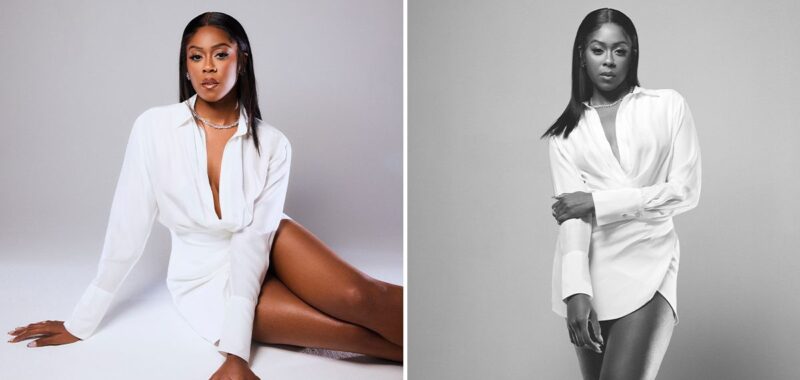For Moses Ingram, starring in Lady in the Lake—the Apple TV+ limited series based on the best-selling Laura Lippman novel of the same name—was a full-circle moment. The actress spent so much of her early life thinking she needed to get out of Baltimore to make a name for herself, only to have one of her biggest projects bring her right back home years later. “It’s really divine,” she tells me of the timing over a Zoom call in early July. For the last four years, the 30-year-old has been building a stacked résumé. You probably recall Ingram from her breakout performance in the 2020 mega hit The Queen’s Gambit, for which she earned an Emmy nomination, followed by pivotal roles in the brooding A24 film The Tragedy of Macbeth and the Disney+ Star Wars series Obi-Wan Kenobi. With Lady in the Lake, Ingram got to work with acclaimed writer-director Alma Har’el (Honey Boy) and Natalie Portman, and her acting dreams were fully realized.
Taking place in 1960s Baltimore, the series begins with an unsolved murder case that inspires housewife and mother Maddie Schwartz (Portman) to leave her comfortable suburban life and marriage behind in pursuit of a lost dream of being an investigative journalist. In her attempt to make a name for herself, Maddie’s work sets her on a collision course with missing woman Cleo Johnson (Ingram), a hard-working activist for Baltimore’s Black progressive agenda and mother juggling multiple jobs.
Ingram landed the role of Cleo in record time, making for a whirlwind shooting experience. I spoke with the actor about her connection to the show’s Baltimore backdrop, the “oh shit” moment of working with Natalie Portman, and collaborating on Cleo’s look with costume designer Shiona Turini.
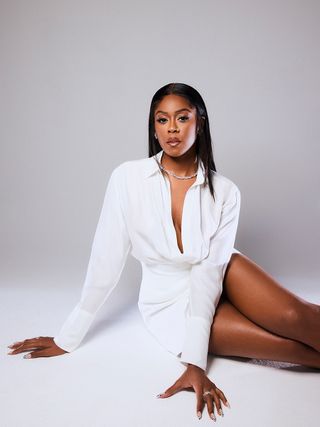
(Image credit: Julian Dakdouk)
Lady in the Lake author Laura Lippman is revered for her detective fiction novels, and a lot of her stories are set in Baltimore, which is where you are from. Were you familiar with Lady in the Lake before being approached about the series?
Not really. There was a real woman who had gone missing and was found in that lake long before I was born, so I had heard about that, but no, never the book or anything like that.
How did you first hear about the show?
It was a super-fast process. My agent hit me at like 8 o’clock one night and was like, “You have to read this right now, like immediately.” I read it and couldn’t put it down. I thought it was amazing. They wanted a tape literally the next day, so I spent up until maybe 7 p.m. getting all the lines in, and then from 7 to midnight, I taped with one of my best friends. I submitted it right after that, and then the next morning, I met Alma, so it was super fast. There was no time to even think about it.
Did being from Baltimore help you connect with the story?
Absolutely. Reading that first episode, they are talking about streets that I know like the back of my hand. I’m from the city properly, so I knew all of these places and could understand the vibe, the feeling. We finally got to shooting, and there were places that I just knew so well. We shot one scene in the same place I graduated from high school and another scene driving down the street where I used to wait for the bus. It was incredibly personal, actually.
What about this story and the character felt like an interesting challenge for you as an actor?
Cleo wants to do well, but it’s the way she has to go about it that is unfortunate. It’s complicated. I think that’s the thing that a lot of people will be able to identify with is—I want to do better, but how? I know my why, but what’s my how? That is interesting to me about Cleo.
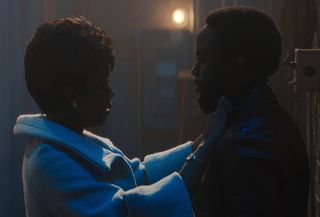
(Image credit: AppleTV+)
You have the incredibly talented Alma Har’el at the helm. What excited you about her vision for bringing this story to life?
Honestly, because it was so fast, we didn’t even really get to have those sorts of conversations. It was all very present tense. One day, early on, we sat down and watched the sizzle reel of everything they had shot so far. Sitting and watching the sizzle reel and looking at Natalie Portman, I was like, “Oh my God, that is Natalie Portman. Jesus ain’t going to put me in this next to Natalie Portman doing work like this.” I think I said a sentence of almost that to Alma, and she was like, “Yeah, you can do that” like it was nothing to her. I really respected her trusting me that I could get in and do it.
What was the timing from meeting Alma to arriving on set?
I think it was two or three weeks. I was in Toronto shooting The Big Cigar at the time, so for the first few shots that we were doing, because of the calendar, I had to fly back and forth out of Toronto to Baltimore. It was crazy, but the experience was everything.
How did you manage going back and forth between these two characters for The Big Cigar and Lady in the Lake? What were some of the things that helped you get into the character of Cleo and prepare for that performance?
Music is really important to me, and this is the first time I’ve worked on a project where the director also had a playlist that she thought was amazing. In school, we say there are things that you get for free. Cleo is a lot of things I get for free. I don’t want to say you don’t have to work for it because you do, but there were things innately that I just understood. There were things that I had seen in my own life.
Like what?
Cleo reminds me so much of my mom and aunts, and I could always know what was going on emotionally with my mother as a child based on what was playing in the house. Mary J. Blige’s Share My World album, I listen to it, and immediately, I can smell Salisbury steak. It’s one of those things. That album I listened to a lot because it makes me think of my mother, which makes me think of Cleo as well, which makes me think of the landscape of the city as well. It all goes together.
What aspects of Cleo and her story did you connect with most?
Probably the go, go, go and working under pressure is something I understand personally and could understand a lot in the moment. There were a lot of times where I felt the things that need to happen in the work have to happen fast, and I want them to go well—me the person but also Cleo the character does as well. We were hand in hand on that I guess. But I do understand that go-getter nature. Nothing in this life is handed to you. If you really want something, you have to make things shake sometimes.
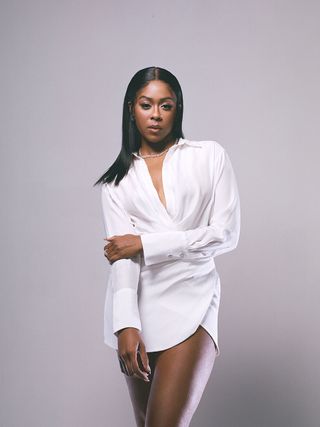
(Image credit: Julian Dakdouk)
We have to talk about working with Natalie Portman.
Natalie is a professional. I don’t know a ton in my life where Natalie Portman hasn’t been Natalie Portman, you know? It doesn’t stop being insane that it’s Natalie Portman. Obviously, you calm yourself down because you don’t want to be off-putting to somebody, but every time I’m next to her, I go, “Oh shit. That’s Natalie Portman.” What an honor it is to work alongside somebody I consider to be a veteran and someone I want to be as good as when I get older, even now. Yeah, a consummate professional. Things just roll off her back and her acting and being in her producorial element at the same time, making sure things flow. Also knowing Natalie is on my team, she wants me to do well. Even now in post and going into press, knowing I’m not by myself, it means a lot to have a vote of confidence from Natalie.
The costumes in this show are incredible and the work of the costume designer Shiona Turini. What did the two of you want to convey about Cleo through her wardrobe?
Shiona’s amazing. I think one thing she did from the very beginning is say, “Cleo is your character, so if something doesn’t feel right about Cleo, something that you’re wearing doesn’t make sense, then you know…” I think the thing about Cleo, the character, is she doesn’t have a lot, so one thing that’s clear in the clothes is that she’s either spending her last to get it or she got it from someone else who already had it. In the beginning, there’s a woman who says, “Oh yeah, you’re wearing the hat that I donated.” I feel like that’s such a huge part of who Cleo is. You have to look the part, and Shiona does a really great job of that. She had a whole board in the costume office. She had Cleo’s colors, and she had Maddie’s colors, and they never wear the same. It’s very interesting.
She wears this gorgeous blue coat a lot throughout. Is there a story behind that piece?
The blue coat was a storyline piece, and that was always going to be there. I know one of my personal favorite looks was the first time Cleo goes into Myrtle Summer’s office, and she has on this green-blue cloak, but the arms are free. It was such a moment, too, because everyone was watching on the monitor, and there’s a moment where you get to see the whole garment. That was a lesson in the job too—how can you better show the clothes and let people see the clothes?
I also loved Cleo’s hair and makeup. She had that iconic ’60s eye with the pastel-blue shadow.
My first day on set was literally drop-in, and because we weren’t able to figure out what the look was before then, we hadn’t really done a consult. This day had to happen. I remember Alma coming in and doing it herself. She was like, “I don’t feel like this is it. Just let me,” and she just came in and did it. I think that scene was the attempted assassination of Myrtle Summer. That was what we went off afterward, and my people came in, Cool Benson and Amber Hamilton. Amber on my hair, Cool on my face. They really did some beautiful things. When you sign up to be an actress, it’s not about being beautiful. It’s whatever the role requires. I do feel like this was the first time I’ve gotten to be and feel pretty, so that was really nice.
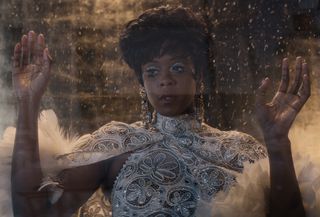
(Image credit: AppleTV+)
Have you seen the series yet?
You know, I never watch. This is the first time, truly, I’ve ever sat down and watched something that I was in. Because of the experience of filming, I had to see how it came out. I remember watching the first episode. I came and watched it in Alma’s office with her, and it was so emotional. You dream of being an actor, and you start working, and it’s like, “Okay, nice. I’m working.” That’s great, but when I dreamt of being an actor, what did I picture? It’s nice to be a part of something that measures up to that.
Lady in the Lake is now streaming on Apple TV+.

